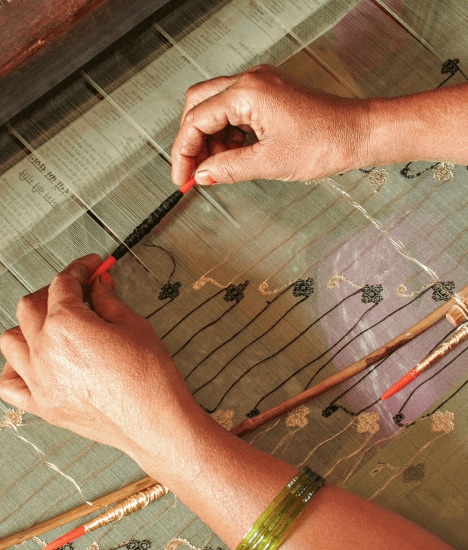Textile Trails: Explore India Through Its Historical Weaves
Know more about the unique fabrics of India which makes up its rich cultural heritage
India’s textiles are a reflection of its exceptional artistic talent and rich cultural heritage. From the delicate handwoven silk sarees of Kanchipuram to the colourful Chanderi fabrics, every corner of India has its unique style of textile. Explore the wide range of fabrics, patterns, and techniques that make up the Indian textiles intricately woven by the hands of weavers made of delicate, vibrant threads.
Kanchipuram Brocade Weave, Tamil Nadu
Kanchipuram is renowned around the world for its excellent Kanchipuram brocade weaving. Kanchipuram silk saris, distinguished for their intricate patterns and lavish gold borders, have come to symbolise tradition and grandeur. The silk yarn used in these saris is hand-woven using Zari threads of silver and gold. With a heritage dating back to more than 150 years, each sari is handcrafted over the course of 4 to 5 days and has designs drawn from traditional patterns, nature, and temples. The end result is a lush, durable and gorgeous fabric.
 Athiya Shetty ina handloom Kanchipuram saree
Athiya Shetty ina handloom Kanchipuram saree
Venkatagiri Weave, Andhra Pradesh
The magnificent Venkatagiri sarees from Andhra Pradesh employ the art of Jamdani weaving. These sarees are made of pure silk or a cotton and silk blend and are woven on traditional pit looms. Beginning with Venkatagiri Raja’s reign, the weaving method has been passed down through 14 generations. The complex motifs on the sarees are made with cotton and zari threads. The yarn is coloured in vibrant hues, and the borders are embellished with elegant dotted lines. The talent and workmanship of the Venkatagiri weavers are evident in these airy, cosy sarees.
 Venkatgiri saree. Picture: Instagram/venkatgiri_handloom_sarees
Venkatgiri saree. Picture: Instagram/venkatgiri_handloom_sarees
Chanderi Weave, Madhya Pradesh
The town of Chanderi of Madhya Pradesh is well known for its gorgeous Chanderi weave, a popular textile with sheer texture and light weight. Due to its exquisite craftsmanship, this traditional art form has been favoured by royalty since ancient times. Chanderi fabrics have motifs based on nature like swans, gold coins, trees, and flowers that are adorned with delicate pastel tones or eye-catching contrasts of vivid colours. Silk, cotton, and zari threads from different parts of India and even from other countries are used to weave the fabric. Using fly shuttle looms, the weaving technique produces fabrics that are breathable, making up for a perfect summer wear.
 The process of making Chanderi saree. Picture: fixthatshirt.com
The process of making Chanderi saree. Picture: fixthatshirt.com
Kinnauri weave, Himachal Pradesh
Intricate geometric patterns are a signature feature of Kinnauri shawls, which are produced in Kinnaur, a scenic district of Himachal Pradesh. These shawls need exceptional expertise to weave using wool. The shawls’ designs have specific religious significance since they use hues that stand for several elements, including water, earth, fire, air, and aether. While conventional colours are primarily used, vegetable dyes are being used in contemporary variations of the weave. Each shawl requires about 45 days to weave using frame looms and pit looms.
 Pit and frame looms are still used to make Kinnauri shawls. Picture: D’source.in
Pit and frame looms are still used to make Kinnauri shawls. Picture: D’source.in
Puan Weave, Mizoram
Mizoram’s rich heritage is on display in the traditional Puan, a woven cloth worn as a lower garment in Mizoram. Puans were historically worn by both men and women due to the variety of styles that were available for various occasions. The puans’ meticulous weaving features a variety of geometric designs, florals, stars, and other native flora and fauna-inspired motifs. Black, white, and red are the primary hues used in puan clothing, giving it vibrancy.
 Mizoram’s traditional Puan weaving. Picture: Instagram/zo_weave
Mizoram’s traditional Puan weaving. Picture: Instagram/zo_weave
Patan Patola Weave, Gujarat
Patan Patola, the exquisite fabric woven from double ikat silk fabric from Gujarat and is an art to behold. Before the weaving process starts, the warp and weft threads are tie-dyed to produce the intricate designs of Ikat. This weaving method, which has roots that go back to the eleventh century, creates stunning designs with vivid colours that really catch the eye. Patola weaving is done on slanted, hand-operated looms constructed of rosewood and bamboo. To create various tints and overlapping colours, careful tying, dyeing, untying, and re-dying is undertaken. The Patan Patola weave is known for its distinctive and eye-catching designs produced by expert weavers of Patan.
 Patan Patola weaving. Picture: D’source.in
Patan Patola weaving. Picture: D’source.in
Sambalpuri Weave, Odisha
The magnificent Sambalpuri sarees from Odisha, which come in silk and cotton, are suitable for celebrations as well as everyday wear. Each thread is delicately woven on a handloom by local weavers from Western Odisha. These sarees include traditional designs derived from the coast, including fish, swans, flowers, shells, and wheels, signifying the coastal state. To achieve uniform colour and preserve the fabric’s quality, the dying procedure is carried out with utmost care. The Sambalpuri sarees are well-known for their connection to Bandhakala, the traditional Ikkat or Ikat tie-dye technique. This time-consuming, meticulous artistry produces beautiful, culturally significant sarees that take more than two weeks to finish.
 Weaving white Sambalpuri saree. Picture: Shutterstock
Weaving white Sambalpuri saree. Picture: Shutterstock












